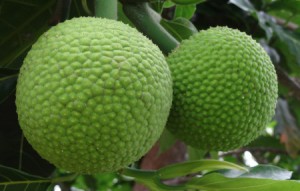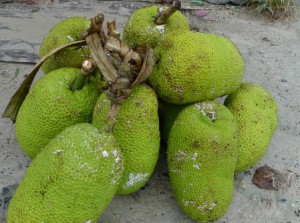Breadfruit
(Artocarpus altilis)
(Artocarpus mariannensis)





Pick when mature but not yet ripe. A pole or long stick is helpful for harvesting breadfruit on the tree. It is best to pick from the tree before it hits the ground, as the breadfruit gets soft and damaged from the fall (Secretariat of the Pacific Community, 2006).
A seasonal crop, so preserve by fermenting, freezing or drying. Ripening can be accelerated by piercing the core and inserting salt water, already ripened breadfruit or wrapping in old cloths and leaves until soft (Secretariat of the Pacific Community, 2006).
US Fish & Wildlife Service


Breadfruit is found in both 1seedless and 2seeded varieties in the Pacific. Varieties differ in leave shapes and fruit shape, size, and time of ripening (Secretariat of the Pacific Community, 2006).